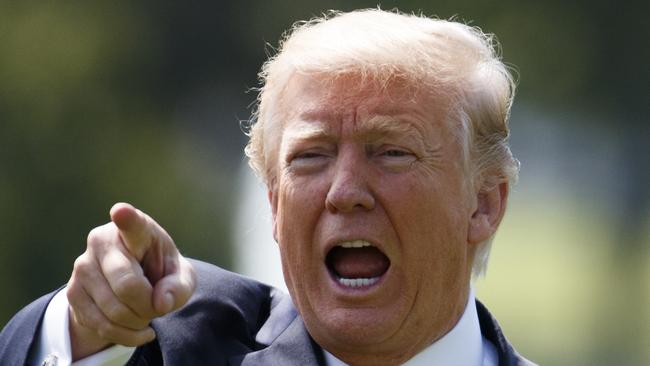Explaining the slide in the US dollar

Over the past year the US dollar has weakened 10 per cent despite strong arguments as to why it should have strengthened.
Trump, departing from the stance of successive US administrations over nearly a quarter of a century, is no advocate for a strong dollar.
A year ago he said the dollar was too strong and was undermining the ability of US companies to compete with China. Since then it has fallen more than 10 per cent against a basket of its major trading partners’ currencies — its biggest depreciation in nearly a decade and a half. He got what he wished for.
That depreciation, however, defies conventional financial wisdom.
The US economy is growing solidly, with the recently-passed tax cuts likely to accelerate that growth.
The US Federal Reserve is far more advanced than its peers in Europe and Japan on the path to normalising monetary policy. It has raised the federal funds rate five times since its nadir post-crisis, has signalled another three increases this year and has started shrinking its balance sheet at a rate that will accelerate through this year.
US bond rates have been rising and, given the need to fund a deficit swollen by the tax cuts — estimated to cost a net $US1.5 trillion over the next decade — and perhaps by a Trump infrastructure package, will result in a lot more bonds being issue and more upward pressure on yields.
The repatriation of the trillions of dollars US companies hold offshore because of the incentives in the Trump tax package is also likely to see some of the companies’ corporate and government bond holdings liquidated to fund special dividends and share buybacks, adding to that pressure.
Normally, rate differentials drive currency relativities and that has been a particular feature of the post-crisis environment amid a desperate search for yield. Given the positive near-term outlook for the US economy and bond yields and, at this point, still no signs of rising inflation levels, the dollar could have been expected to strengthen.
It is worth noting that the eurozone and Japan have improved their appeal as destinations for global capital flows.
Their economies are finally improving off ultra-low bases and the scale of their unconventional monetary policies — their bond-buying — is being reduced, albeit that they are still running big asset-purchasing programs. Yields on their bonds, however, remain negligible.
It is possible, however, in an environment where there is growth in all the major economies, that there is greater upside seen in economies other than the US.
It is also conceivable that when foreign investors look at the US they see little appeal in investing in a stockmarket that has inflated to levels that appear stretched, or in buying US government bonds against the backdrop of an existing $US20 trillion pile of government debt that will only grow as the Trump tax and infrastructure programs have to be funded.
The US remains, however, the world’s reserve currency. Almost 64 per cent of the world’s foreign exchange reserves are held in US dollar-denominated assets.
That is a little lower that its peak of just over 66 per cent, with central banks diversifying their holdings and China’s inclusion in the International Monetary Fund’s basket of currencies making up its “special drawing rights’’ alternative reserve asset class for central banks siphoning off some of the flows.
Nevertheless the dollar’s dominant role in global finance is currently unchallenged, even if China has long-term ambitions to be a challenger.
Beyond the perception that the US’s credit status is set to deteriorate significantly, there may be some other factors at play.
The unpredictability and controversies associated with Trump and his administration, the revolving door of senior figures and the dysfunctional nature of Congress are generating a level of volatility at a political level that would unsettle foreign investors.
It is also probable that Trump’s “America First’’ rhetoric — now translating into actions — is also playing a role in reducing the appeal of the dollar.
This week’s imposition of tariffs on solar panels and washing machines and the imminence of either a rewriting of the 24-year-old North American Free Trade Agreement with Canada and Mexico in favour of the US, or of a US decision to abandon the agreement, are adding to the belief that Trump’s protectionist convictions are going to be increasingly evident in the administration’s actions this year.
The solar panel tariff is aimed directly at China, which dominates their manufacture. The administration will have more opportunities in the coming weeks and months to target imports from China or, as it has done with this week’s action, product categories where Chinese companies are major players, whether the products are manufactured in China or produce elsewhere.
China has, of course, already warned that it might challenge any US protectionist measures within the World Trade Organisation processes, not that Trump would be overly concerned if it did, given his suspicion of multilateral organisations and his campaign threat to pull the US out of the WTO.
China is also, however, the US government’s biggest creditor, holding more than $US1 trillion of its bonds. There have been reports that it is considering slowing or halting its purchases.
Japan is another big investor in the US Treasuries market. It, too, has more than $US1 trillion exposed and — whether specifically targeted or not — would inevitably be affected by the fallout from a full-scale trade war between the US and China.
Indeed, we’d all be affected, including the US, if the US materially reverses its longstanding commitment to free trade.
A fear that protectionism could rebound on the US and cause self-inflicted damage to the US economy may be another strand in the explanation for the US dollar weakness, which is the flip side of the surprising recent Australian dollar strength.



If Donald Trump is prepared to claim credit for a soaring US stockmarket, as he does, should he also shoulder the credit, or blame, for a big fall in the value of the US dollar?